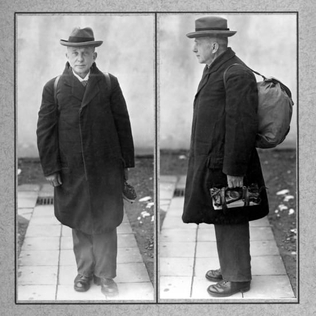Top Qs
Timeline
Chat
Perspective
Adolf Seefeldt
German serial killer From Wikipedia, the free encyclopedia
Remove ads
Adolf Gustav Seefeldt (6 March 1870 – 23 May 1936), known as The Sandman, was a German serial killer.
This article needs additional citations for verification. (April 2025) |
Remove ads
Life
Summarize
Perspective
Early life
Born as the seventh and youngest child of his parents, Adolf was initially trained as a locksmith, then as a watchmaker who repaired grandfather clocks and pocket watches. He moved to Lübeck in 1890 and married Katarina Seefeldt, who divorced him in 1910. His son was committed to a lunatic asylum for moral crimes at the age of nineteen.
Seefeldt was reportedly abused by two men at the age of 12. He was first imprisoned at 25 for the sexual harassment of a boy. Psychiatrists diagnosed him as mentally unstable, which led to him spending most of his life in mental hospitals and prisons.
Serial murders
The traveler and watchmaker Adolf Seefeldt, also known as "Sandman" or—because of his profession—"Uncle Tick Tock" and "Uncle Adi," abused and killed at least twelve boys during the reign of the Third Reich. He usually selected pine groves as crime scenes, with one exception. A common feature among the victims was their clothing, as they consistently wore sailor suits. Since all the children appeared to be “sleeping peacefully” and showed no signs of external violence, the police were mystified by the circumstances of death. It is therefore possible that Seefeldt committed additional murders that were misclassified as natural deaths.
Contemporary experts speculated that Seefeldt used his own homemade poison, chloroform, or smothered his victims. According to Hans Pfeiffer, a well-known author of popular science books on authentic criminal cases, these theories were easily disproven.[citation needed] Pfeiffer instead suspected that Seefeldt had placed his victims into a hypnotic sleep, then likely performed oral sex on them and left them asleep in the woods, failing to awaken them from hypnosis. The children later died of hypothermia, which Seefeldt had either accepted or intended.
Remove ads
The victims
His victims ranged from toddlers to 12-year-old boys: Kurt Gnirk (16 April 1933), Wolfgang Metzdorf (8 October 1933), Ernst Tesdorf (2 November 1933), Alfred Prätorius (12 November 1933), Hans Korn (16 January 1934), Günter Tieske from Oranienburg (2 October 1934), 11-year-old Erwin Wishnewski from Brandenburg (8 October 1934), 4-year-old Artur Dill and 5-year-old Edgar "Eipel" Dittrich (16 October 1934, both found in Neuruppin), 10-year-old Hans-Joachim Neumann (killed 16 February 1935; found on 20 June 1935), 10-year-old Heinz Zimmerman (23 February 1935), and 11-year-old Gustav Thomas (22 March 1935).[1] The investigative authorities assumed that the actual number of casualties was much higher,[2] possibly claiming up to 100 lives.[citation needed]
Gustav Thomas case
The lawyer Wilhelm Hallermann summarized the murder case of 11-year-old Gustav Thomas (found in a pine forest near Wittenberge), stating that microscopic examinations revealed bloodshot pressure, indicating strangulation.
The medical examiner Victor Müller-Heß testified during the murder trial against Seefeldt, asserting that the victims were not poisoned but instead strangled.[3]
Remove ads
Trial and execution
Summarize
Perspective
The Schwerin jury, under the chairmanship of District Court Director Karl Friedrich Sarkander and the advisory District Court Councils Wilms and Weise, consisted of butcher Ernst Hahn from Crivitz, secretary Wilhelm Schneeweis from Schwerin, Ortsgruppenleiter Friedrich Jahnke from Parchim, Mayor Ernst Dubbe from Leussow, engineer Otto Arpke from Lübtheen, and city councilor Kreisleiter Buhr from Ludwigslust. The case was heard on January 21, 1936. The chief prosecutor was Wilhelm Beusch, whom Bishop Bernhard Schräder recalled in connection with the case of Vicar Leo Wiemker.[4][5]
In the presence of the later war criminal and Reichsstatthalter of Mecklenburg, Friedrich Hildebrandt railed against the accused to justify the eradication of such behavior.[6] Adolf Seefeldt's defense lawyer was Rudolf Neudeck.[7] August Brüning (1877–1965) was a participating expert in the trial.
After the closing arguments of February 21, the verdict for the murder cases was announced the following day. Seefeldt was sentenced to death. According to the Niederdeutschen Beobachter on February 29, 1936, Seefeldt is said to have filed an appeal. Neither a revision nor a revision procedure is historically documented; the judgment was enforced after legal force and the denial of a pardon on May 23, 1936. The records of Seefeldt's conviction are poor. In addition to newspaper reports of his execution, there are only two memory protocols of conversations conducted in April 1936 in his cell in Schwerin.[8] The case of Adolf Seefeldt was discussed by J. Fischer and Johannes Lange in the Monthly Journal of Forensic Biology and Penal Reform.
Execution
Earlier, the executioner Carl Gröpler had visited him and "recognized the expected difficulty of the execution." Seefeldt was allegedly eager to be beheaded the next morning by the guillotine.[9]
See also
References
Literature
External links
Wikiwand - on
Seamless Wikipedia browsing. On steroids.
Remove ads

